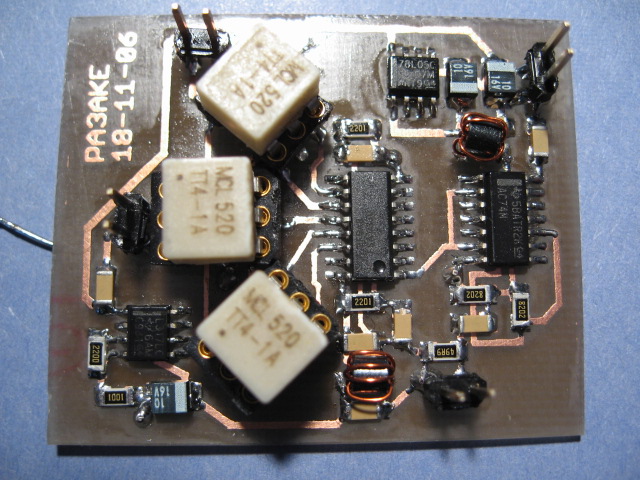|
Fairchild FSAV330

The FSAV330 (SOIC-16 package) contains 4 SPDT switches with a common control line. Only 2 switches are needed to implement the H-Mode mixer. The PCB layout of the FSAV330 with the 3 TT4-1A transformers is very compact indeed. The FSAV330 does not require an 74AC74 divide by two squarer as it does not need both Q and !Q. However in this test the 74AC74 squarer is used.
The following table summarizes the measurements with the FSAV330:
| FSAV330 + TT4-1A + 74AC74 |
Vdd = 7.0V, Vbias = 1.9V |
Best bias |
| Band |
BPF |
mixer |
MDS -dBm |
IF rej |
spur |
mixer IIP3 (dBm) @ 20KHz spacing |
Bias |
IIP3 |
| IL |
CL |
- |
+ |
|
avg |
-6 |
-3 |
0 |
+3 |
+5 |
|
0 |
| -dB |
-dB |
BPF |
BPF |
-dB |
dB |
dBm |
dBm |
dBm |
dBm |
dBm |
V |
dBm |
| 160 |
3,3 |
5,08 |
132 |
128 |
33,6 |
|
|
|
41,9 |
|
|
1,9 |
41,9 |
| 80 |
1,4 |
5,00 |
133 |
131 |
33,2 |
|
40,5 |
41,2 |
42,2 |
43,0 |
33,2 |
1,9 |
42,2 |
| 40 |
2,3 |
4,96 |
133 |
130 |
32,0 |
|
|
|
40,4 |
|
|
2,0 |
40,4 |
| 30 |
3,4 |
4,96 |
133 |
129 |
32,4 |
|
|
|
39,0 |
|
|
1,9 |
39,0 |
| 20 |
3,4 |
4,96 |
133 |
129 |
31,6 |
|
|
|
37,4 |
|
|
2,0 |
37,4 |
| 17 |
3,0 |
4,96 |
133 |
129 |
30,8 |
|
|
|
37,3 |
|
|
2,0 |
37,3 |
| 15 |
3,9 |
4,96 |
132 |
128 |
28,4 |
9,3 |
|
|
35,1 |
|
|
2,0 |
35,1 |
| 12 |
3,7 |
4,92 |
133 |
129 |
27,6 |
|
|
|
34,8 |
|
|
2,0 |
34,8 |
| 10 |
2,3 |
5,00 |
133 |
125 |
28,4 |
|
|
|
35,5 |
|
|
2,3 |
36,5 |
| 6 |
|
5,72 |
126 |
128 |
23,2 |
|
|
|
34,5 |
|
|
3,0 |
42,0 |
The FSAV330 is tested at 7V Vdd. The best overall bias point is found to be at 1.9V. Especially on 160M and 80M this bias point is improving over the midpoint. On the higher bands the difference is not big except on 6M where the IMD drops considerably at higher bias point values. Although I do not trust that figure very much as it is NOT following 3rd order behavior at all! The optimum bias point is found to depend on the input termination of the mixer. A step attenuator set at 0dB before the mixer gives different results than no step attenuator at all.
Because of the low bias point voltage, IP3 above +3dBm input level is deteriorating rapidly.
The spur reduction on 15M is the worst of all tested mixers, with an average spur level of +9.3 dB above MDS for 130 spurs.
Like the FSAV430, the 9MHz RF-IF isolation is not very impressive.
MDS level on 6M is very poor indeed.
Finally an experiment is done by connecting the two unused switches in parallel with the other two. Only +/- 0.1dB improvement in conversion loss was observed. The IP3 is not influenced at all. The spur reduction is noticeably worse.
Back to Switches
Back to the TOC
|